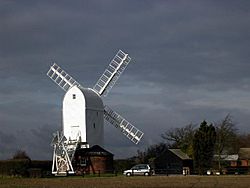Aythorpe Roding Windmill facts for kids
Quick facts for kids Aythorpe Roding Mill |
|
|---|---|

The restored mill in February 2005
|
|
| Origin | |
| Mill name | Aythorpe Roding Mill |
| Mill location | TL 590 152 |
| Coordinates | 51°48′43″N 0°18′25″E / 51.812°N 0.307°E |
| Operator(s) | Privately Owned |
| Year built | ca. 1779 |
| Information | |
| Purpose | Corn mill |
| Type | Post mill |
| Storeys | Three storeys |
| Roundhouse storeys | Single storey roundhouse |
| No. of sails | Four sails |
| Type of sails | Patent sails |
| Windshaft | Cast iron |
| Winding | Fantail |
| Fantail blades | Six blades |
| No. of pairs of millstones | Two pairs |
Aythorpe Roding Windmill is a special old windmill in Essex, England. It's a "post mill," which means its whole body can turn to face the wind. This mill is so important that it's a "Grade II* listed building," meaning it's protected for its historical value. Today, it has been carefully fixed up and can work again!
Contents
History of Aythorpe Roding Windmill
This windmill stands where an even older mill once stood in 1615. The current mill was likely built in 1779. We know this because "Built 1779" is carved into one of its wooden beams.
The mill was insured in 1798 for £50. By 1805, its value had grown to £140. In 1846, maps showed it had an "open trestle" base.
Around 1860, the mill was put up for sale to be taken apart. But instead, it got a big upgrade! Its old "common sails" were replaced with "patent sails." A strong cast-iron shaft replaced the old wooden one. The millstones were also moved to a new position.
A "roundhouse" was added to protect the base and store things. A "fantail" was also installed. This clever device automatically turns the mill to face the wind, so no one had to do it by hand anymore. By 1890, a steam engine was even added to help power an extra set of millstones.
The mill kept working until 1937. In 1940, the local council took over its lease. A big restoration project finished in 1982. The mill ground grain again on March 3, 1982. It officially opened to visitors on April 30, 1983.
How Aythorpe Roding Windmill Works
Aythorpe Roding Windmill is a "post mill" with a single-storey roundhouse. This means the main part of the mill, called the "body," sits on a large central post. The entire body can rotate on this post.
The mill has four "double patent sails." These are the large arms that catch the wind. They are attached to a strong cast-iron shaft. Inside, two pairs of millstones grind grain. A "fantail" at the back helps the mill automatically turn into the wind. The mill stands about 13.5 meters (44 feet 3 inches) tall to its roof.
The Mill's Base: Trestle and Roundhouse
The main post of the mill is about 6.17 meters (20 feet 3 inches) long. It's very thick, about 76 centimeters (30 inches) by 74 centimeters (29 inches) at its base. This strong post supports the entire mill body.
The "roundhouse" is a circular building at the bottom of the mill. It protects the wooden frame, called the "trestle," that supports the main post. It also provides space for storage. A date of 1869 found on a beam likely shows when the roundhouse was built.
The Mill's Body and Size
The main part of the mill, called the "body," measures about 6.4 meters (21 feet) by 3.6 meters (12 feet). This makes it the largest post mill in the Essex area.
Sails and Windshaft
The mill has four "double patent sails." These are special sails that can adjust themselves to the wind automatically. This is much more efficient than older "common sails." The sails are connected to a "windshaft," which is a large cast-iron rod. This windshaft turns the gears inside the mill. The current cast-iron windshaft replaced an older wooden one.
Inside the Mill: Machinery
The "Brake Wheel" is a large wooden wheel with a cast-iron center. It's about 3.1 meters (10 feet 2 inches) across. This wheel helps control the speed of the mill.
Originally, the millstones were arranged differently. But when the cast-iron windshaft and patent sails were added, the millstones were moved to a "breast stone layout." This means they are positioned closer to the front of the mill. Other important parts include the "wallower" and the "great spur wheel," which are gears that transfer power to the millstones.
Millers Who Worked Here
Many people have worked at Aythorpe Roding Windmill over the years:
- William Glasscock (1615) - worked at the earlier mill
- Joshua Wright (1798)
- Joseph Knight (1805)
- Tabrum (1833)
- Stephen Crossingham (1848 - 1850)
- E P Bennett (1866)
- James Webster (1874 - 1878)
- Charles Large (1882)
- Thomas Belsham (1890)
- Ernest and John Belsham (1906 - 1937)
Aythorpe Roding Windmill in Media
Aythorpe Roding Windmill was featured in an episode of a TV show called The Protectors. The episode was titled Triple Cross and was filmed in 1972.

